
By Kathy Torres
We live in a world in which good physical and mental health is emphasized and encouraged constantly, through what we watch, read, and hear. It seems a basic intention for us to try to be healthy and happy, even though the goal is at times difficult to reach. Eating the right foods, getting adequate sleep, and exercising are at the top of the list to help us get there, however, as humans, we have needs outside of the physical that directly affect our happiness, for example, the desire for accomplishment, friendship, love, excitement, challenge, affirmation, and quiet. It’s a complicated formula, different for each of us, however, there are some common threads. I’m guessing that if you’re reading this blog, you have an interest in gardening, but, did you know that gardening is beneficial to your health? Here are some positive effects, for both physical and mental well-being.
Good Exercise:
Gardening is great for 3 types of exercise – aerobic, strength building, and flexibility. Digging, squatting, reaching, pushing, and lifting burns calories providing a workout that is good for the heart. Decrease your anxiety after a bad day, by getting out in the yard and pulling a few weeds to release your frustration and anger. That will give your blood pressure a break! For older folks, gardening keeps you moving, so important for maintaining mobility. Also, working hard will often help to get a good night’s sleep.
All of the activities mentioned above also work the other muscles and joints, contributing to overall strength and flexibility. For some very scientific data on the effects of gardening on your physical health, check out this study published by the American Society for Horticultural Science (Click HERE). The study concludes gardening tasks performed by adults are moderate to high-intensity physical activities.
Vitamin D – Too much sun is not good for the skin, we know that, but we need sunlight to give our bodies enough Vitamin D. The body makes vitamin D when direct sunlight converts a chemical in skin into an active form of the vitamin (calciferol). A healthy dose of vitamin D increases the body’s ability to absorb calcium, which benefits bones and the immune system. Studies suggest that people who get enough vitamin D and calcium can slow bone mineral loss, help prevent osteoporosis and reduce bone fractures.
Growing Your Own Food – The most obvious health benefit of gardening is growing your own food. You will have access to the freshest fruits and vegetables, fertilizers and pesticides can be controlled or eliminated, and you’ll save the money you may have spent on expensive organic foods in the grocery store. Last, vegetables allowed to ripen in the garden have more nutrients than some you buy at the store that may have been picked early.
Connecting with Nature – If you feel good when you walk through a park, botanical garden, or your own landscape, taking in the fresh air, birds singing, and the colors of spring, fall, or any season, you are connecting to nature. The enjoyment of watching a hummingbird at a feeder, digging in the soil, planting seeds and watching them grow, or watering a garden, is connecting to nature. Finding this escape from the hectic pace of life can relieve anxiety, improve mood, and bring about a calming force by helping you to let go, take a deep breath, and just relax. Connecting with nature is therapy for the heart, mind, and soul.
Gardening Makes us Happy – Shopping for plants always makes me happy – I would much rather survey racks of annuals and perennials rather than clothes or shoes. Planting flowers or shrubs and trees to create a garden room or improve the curb appeal of your home offers an opportunity to use those creative instincts, and a little hard work can be very satisfying. The planning, purchasing, and planting of a new garden bed or simply adding to what you’ve got, gives pleasure and a sense of accomplishment and pride. And, honestly, getting a little dirt under the fingernails feels pretty good! Gardening is good therapy for depression. Being outside in the fresh air can be a good distraction while digging in the dirt and planting something beautiful provides a feeling of hope and encouragement.
Family Activity – Gardening is a wonderful family activity, providing kids and adults an opportunity to get outside (away from TVs, phones, computers, video games, etc.), to learn about plants and what is needed to care for them. A vegetable garden is a way to see exactly where food comes from and can hold interest, by checking each day on the progress and then, finally, harvesting and eating! By working together, a family vegetable garden becomes a place to gather, work, and discover.
Builds Self-Esteem and Encourages Friendship – Many people will say, “Oh, I just don’t have a green thumb.” A few failures can certainly diminish confidence, but often it’s just a matter of learning the ropes on proper planting, fertilizing, light requirements and watering. Once educated, success is much more likely and can provide confidence and self-esteem. Talking to others who have the “gardening bug” in common offers an avenue to friendship and sharing.
Dementia Benefits – National Institute of Health (NIH), the National Library of Medicine cites research conducted on the benefits of gardening for people with dementia. “The usefulness of activating the senses, particularly those of touch and smell; the significance of being occupied in meaningful, productive work; the importance of cultivating a sense of curiosity, wonder, and learning; the positive gains derived from socialization in a group context; the peace and hope derived from being ‘in the moment’; and the positive mental and physical well-being derived from participating in the outdoor garden. Our findings support the integration of therapeutic gardening as a valuable practice for people with dementia.” To access this article and additional resources, click HERE.
The Dirt on Dirt – Believe it or not, there is evidence that certain microbes found in soil can contribute to a decrease in stress and even asthma. Those of us who enjoy digging in the dirt are not surprised. See the links below if you’d like to read more. Covid certainly brought about an enhanced effort to keep our hands clean, but maybe we need to adjust a bit, unless we are ill.
Fat in soil bacteria may protect against stress (medicalnewstoday.com)
Hygiene Hypothesis: Could More Dirt and Germs Boost Your Health? | US News
Other than just a hobby to enjoy, gardening IS actually good for us. The benefits are many and can go a long way to improve physical and mental health. I love this quote from Calvin Coolidge, the 30th President of the United States. “All growth depends on the activity. There is no development physically or intellectually without effort, and effort means work.” Staying healthy and happy takes work, so let’s get busy! With spring right around the corner, it’s time to make a plan for planting flowers, creating a new plant bed, or starting a family vegetable garden. Get the kids involved in researching and planning. Staff at Wingard’s Market are available and ready to assist you in selecting plants, soil, and everything else you need for a spring project. Go ahead and get your hands dirty…. you will reap many rewards!

 So… Here we are in the “dog days” of summer when it’s hot and dry and hard to get motivated to get out in the yard that we were so devoted to in spring. We just want to sit by the pool and sip on a nice, cold drink, right? Unfortunately, it’s the time of year when disease, pests, and weeds begin to affect the beauty of the landscape, and we have to muster up the will to take care of a few problems. For example: Our gorgeous rose bushes were just attacked by japanese beetles (they visited in June); the foliage on the azaleas is being eaten; the crape myrtle has powdery mildew; and brown patch is beginning to rear its ugly head, along with nutsedge in the lawn. Hopefully, you don’t have all of these issues, but it’s likely you’ve “been there, done that” with at least one of them.
So… Here we are in the “dog days” of summer when it’s hot and dry and hard to get motivated to get out in the yard that we were so devoted to in spring. We just want to sit by the pool and sip on a nice, cold drink, right? Unfortunately, it’s the time of year when disease, pests, and weeds begin to affect the beauty of the landscape, and we have to muster up the will to take care of a few problems. For example: Our gorgeous rose bushes were just attacked by japanese beetles (they visited in June); the foliage on the azaleas is being eaten; the crape myrtle has powdery mildew; and brown patch is beginning to rear its ugly head, along with nutsedge in the lawn. Hopefully, you don’t have all of these issues, but it’s likely you’ve “been there, done that” with at least one of them. Blueberries are often labeled a “superfood” because they are loaded with vitamins and minerals. The deep blue color comes from anthocyanin, an antioxidant that can help protect the body from heart disease and cancer, reduce inflammation and increase immune function. Research also suggests the compounds found in blueberries may boost brain health, lower blood sugar levels, and improve insulin sensitivity. A half cup of blueberries a day just might be what the doctor ordered! Wouldn’t it be great to rely on your own backyard blueberry bushes to provide them? Did I mention they are also low in calories?
Blueberries are often labeled a “superfood” because they are loaded with vitamins and minerals. The deep blue color comes from anthocyanin, an antioxidant that can help protect the body from heart disease and cancer, reduce inflammation and increase immune function. Research also suggests the compounds found in blueberries may boost brain health, lower blood sugar levels, and improve insulin sensitivity. A half cup of blueberries a day just might be what the doctor ordered! Wouldn’t it be great to rely on your own backyard blueberry bushes to provide them? Did I mention they are also low in calories? Blueberries grow best in well-drained soil that has plenty of organic matter. We recommend Stout Ollie, a mixture of three different organic composts. If you have heavy clay soil or poor drainage, amend the soil by mixing in soil conditioner (finely ground pine bark). Mounding the soil 6”-12” high and 2’-3’ wide is another way to improve drainage in clay soil. Keep plants adequately watered, especially during the first few years while they become established. Blueberry bushes can retract water from berries during fruit production, so it is essential for the plant to receive adequate water through the roots in order to produce plump, juicy berries. Next year’s buds are set in late summer and early fall, another reason they must receive adequate moisture. Add mulch to help retain moisture and reduce weeds.
Blueberries grow best in well-drained soil that has plenty of organic matter. We recommend Stout Ollie, a mixture of three different organic composts. If you have heavy clay soil or poor drainage, amend the soil by mixing in soil conditioner (finely ground pine bark). Mounding the soil 6”-12” high and 2’-3’ wide is another way to improve drainage in clay soil. Keep plants adequately watered, especially during the first few years while they become established. Blueberry bushes can retract water from berries during fruit production, so it is essential for the plant to receive adequate water through the roots in order to produce plump, juicy berries. Next year’s buds are set in late summer and early fall, another reason they must receive adequate moisture. Add mulch to help retain moisture and reduce weeds. Do not fertilize blueberry bushes when first planted. Wait until the following spring. From that point, fertilizer should be applied twice a year. Apply Holly-tone when spring growth begins and again in June. Do not use nitrate forms of fertilizer for blueberries as this will cause root damage.
Do not fertilize blueberry bushes when first planted. Wait until the following spring. From that point, fertilizer should be applied twice a year. Apply Holly-tone when spring growth begins and again in June. Do not use nitrate forms of fertilizer for blueberries as this will cause root damage. The sights and sounds of water provide a relaxing, soothing atmosphere in the garden. An extra reward is the attraction of pollinators, frogs, butterflies, and other beneficial wildlife. As water gardens and ponds have gained popularity, so has interest in plant life to enhance the natural appearance of these landscape additions. There are many aquatic plants for use in natural, as well as man made water features that, in addition to just being beautiful, add oxygen, help to control algae and provide a home or hiding place for wildlife.
The sights and sounds of water provide a relaxing, soothing atmosphere in the garden. An extra reward is the attraction of pollinators, frogs, butterflies, and other beneficial wildlife. As water gardens and ponds have gained popularity, so has interest in plant life to enhance the natural appearance of these landscape additions. There are many aquatic plants for use in natural, as well as man made water features that, in addition to just being beautiful, add oxygen, help to control algae and provide a home or hiding place for wildlife.  Saururus cernuus AKA Lizard’s Tail – Deep green heart shaped leaves. Gracefully arching spikes of tiny white flowers 4-6 in. shaped like a lizard’s tail. Will flower even in dense shade. The plant grows to height of 3-4 feet. Plant in a medium pot with water from 1-6 in. over crown of plant.
Saururus cernuus AKA Lizard’s Tail – Deep green heart shaped leaves. Gracefully arching spikes of tiny white flowers 4-6 in. shaped like a lizard’s tail. Will flower even in dense shade. The plant grows to height of 3-4 feet. Plant in a medium pot with water from 1-6 in. over crown of plant.  Lobelia fulgens ‘Queen Victoria’ AKA Cardinal Flower provides interest all season with rich burgundy foliage. Upright stalks can grow to heights of 2-3 ft. Striking red flowers in late summer. May be planted in 1-3 inches of water. Grow in sun to part shade.
Lobelia fulgens ‘Queen Victoria’ AKA Cardinal Flower provides interest all season with rich burgundy foliage. Upright stalks can grow to heights of 2-3 ft. Striking red flowers in late summer. May be planted in 1-3 inches of water. Grow in sun to part shade. Juncus effuses ‘Spiralis,’ commonly known as Corkscrew Rush has attractive corkscrew stems which are both upright and prostrate, cylindrical, green, and smooth. They grow in 1-6 inches of water over the crown into a clump 12-18 inches tall and wide with late summer yellowish-green flowers. Full sun is best but some shade can be tolerated.
Juncus effuses ‘Spiralis,’ commonly known as Corkscrew Rush has attractive corkscrew stems which are both upright and prostrate, cylindrical, green, and smooth. They grow in 1-6 inches of water over the crown into a clump 12-18 inches tall and wide with late summer yellowish-green flowers. Full sun is best but some shade can be tolerated.  Juncus effusus / Soft Rush – Soft, grass like stems grow in clumps that rarely intrude upon other plants. Each stem bears a cluster of very small, greenish brown, scaly flowers that bloom in July through September from a point on the stalk near the top. Grows to a height up to 1 ft. tall.
Juncus effusus / Soft Rush – Soft, grass like stems grow in clumps that rarely intrude upon other plants. Each stem bears a cluster of very small, greenish brown, scaly flowers that bloom in July through September from a point on the stalk near the top. Grows to a height up to 1 ft. tall. Nymphaea ‘Georgia Peach’ is a hardy, free-flowering, showy water lily with a long bloom season. Blooms stand 3-4 inches above the water surface. It is very adaptable to different growing situations. Use in medium to large water gardens.
Nymphaea ‘Georgia Peach’ is a hardy, free-flowering, showy water lily with a long bloom season. Blooms stand 3-4 inches above the water surface. It is very adaptable to different growing situations. Use in medium to large water gardens. Nymphaea Pink ‘Sensation’ is considered one of the best hardy pink water lilies. Blooms are held above the waterline, stay open later in the day, are free-flowering and have a slight fragrance. Use in any size water garden.
Nymphaea Pink ‘Sensation’ is considered one of the best hardy pink water lilies. Blooms are held above the waterline, stay open later in the day, are free-flowering and have a slight fragrance. Use in any size water garden. Nymphaea Albatros has beautiful, star-shaped, snow white flowers. A free flowering hardy white water lily, it will perform well in full sun or partial shade. The new foliage is deep burgundy and turns a deep olive green as it matures. Flowers stay open later in the day.
Nymphaea Albatros has beautiful, star-shaped, snow white flowers. A free flowering hardy white water lily, it will perform well in full sun or partial shade. The new foliage is deep burgundy and turns a deep olive green as it matures. Flowers stay open later in the day. Thalia Dealbata AKA Hardy Water Canna – Purple flowers on top of tall, graceful stems. Large blue-green leaves. Will grow to heights of 4-6 feet. Do not allow crown of plant to freeze during winter. Plant in a medium pot with water from 1-2 ft. over crown of plant.
Thalia Dealbata AKA Hardy Water Canna – Purple flowers on top of tall, graceful stems. Large blue-green leaves. Will grow to heights of 4-6 feet. Do not allow crown of plant to freeze during winter. Plant in a medium pot with water from 1-2 ft. over crown of plant.  Vallisneria americana AKA Water Celery is an evergreen perennial with clusters of ribbon-like leaves, about 1 inch wide that can grow up to 3 ft. long, producing single white flowers that grow to the water surface. After pollination, the flower stalks curl into spirals and pull the flowers underwater, where they form capsules containing many tiny seeds. Very fast grower, able to reach full height in 2 months. Performs best in full sun to light shade in water 12-48 inches deep.
Vallisneria americana AKA Water Celery is an evergreen perennial with clusters of ribbon-like leaves, about 1 inch wide that can grow up to 3 ft. long, producing single white flowers that grow to the water surface. After pollination, the flower stalks curl into spirals and pull the flowers underwater, where they form capsules containing many tiny seeds. Very fast grower, able to reach full height in 2 months. Performs best in full sun to light shade in water 12-48 inches deep. SNAP BEANS: Rapid growing, early maturing and productive, bush and pole (vine) form snap beans are a popular choice for the home garden.
SNAP BEANS: Rapid growing, early maturing and productive, bush and pole (vine) form snap beans are a popular choice for the home garden. TOMATOES: Hundreds of tomato cultivars are available, so make it easy on yourself and start with these, which are all fairly disease resistant. Staking, caging, and trellising are good ways to keep the plants and fruit up and off the ground, providing easier access for picking and spraying, and allows airflow to prevent disease. Pinch off suckers growing between the main stalk and branches.
TOMATOES: Hundreds of tomato cultivars are available, so make it easy on yourself and start with these, which are all fairly disease resistant. Staking, caging, and trellising are good ways to keep the plants and fruit up and off the ground, providing easier access for picking and spraying, and allows airflow to prevent disease. Pinch off suckers growing between the main stalk and branches.
 CUCUMBERS: Cucumber plants grow in two forms: vining and bush. Vines need a trellis to keep them off the ground, and produce more fruit the more you harvest. To remove the fruit, use a knife or clippers, cutting the stem above the fruit. Pulling them may damage the vine. Don’t let the cucumbers get oversized or yellow on the end or they will be bitter.
CUCUMBERS: Cucumber plants grow in two forms: vining and bush. Vines need a trellis to keep them off the ground, and produce more fruit the more you harvest. To remove the fruit, use a knife or clippers, cutting the stem above the fruit. Pulling them may damage the vine. Don’t let the cucumbers get oversized or yellow on the end or they will be bitter. YELLOW SUMMER SQUASH are harvested when immature, while the rind is still tender and edible.
YELLOW SUMMER SQUASH are harvested when immature, while the rind is still tender and edible. BELL PEPPERS are a warm-weather fruit, appreciated for cooking and eating raw. Crunchy, sweet bell pepper plants lack capsaicin, the active component in hot peppers that gives them their heat. The fruits can be harvested when they are green, to increase the yields. Alternatively, the fruits can be allowed to ripen to red, leaving them time to develop flavor with smaller yields. Provide support for the limbs, to hold the weight of the peppers by caging or staking.
BELL PEPPERS are a warm-weather fruit, appreciated for cooking and eating raw. Crunchy, sweet bell pepper plants lack capsaicin, the active component in hot peppers that gives them their heat. The fruits can be harvested when they are green, to increase the yields. Alternatively, the fruits can be allowed to ripen to red, leaving them time to develop flavor with smaller yields. Provide support for the limbs, to hold the weight of the peppers by caging or staking.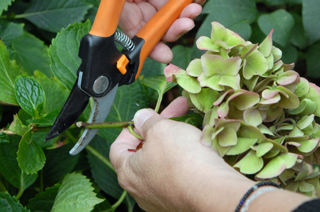 As we survey our landscape in anticipation of the upcoming spring season, and notice that the weathered blooms remain on our hydrangeas, the question arises… Was I supposed to cut those off in the fall? Before you grab your pruning shears, there are a few things you need to know about caring for this beautiful southern shrub. There is not one rule for all hydrangeas, and if you prune at the wrong time, you will ruin your chance to enjoy the gorgeous blooms.
As we survey our landscape in anticipation of the upcoming spring season, and notice that the weathered blooms remain on our hydrangeas, the question arises… Was I supposed to cut those off in the fall? Before you grab your pruning shears, there are a few things you need to know about caring for this beautiful southern shrub. There is not one rule for all hydrangeas, and if you prune at the wrong time, you will ruin your chance to enjoy the gorgeous blooms.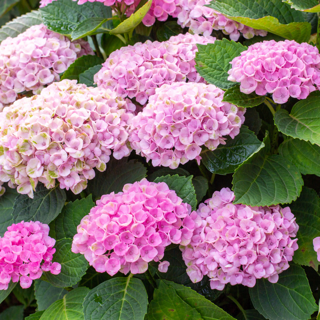 Hydrangea macrophylla – Bigleaf or French Hydrangeas bloom in mophead or lace cap form. Bloom color is determined by the soil pH (relative to aluminum in the soil) and is typically blue or pink, however, there are some cultivars with white blooms. A few popular cultivars are Endless Summer, Big Daddy, Mini Penny, Twist-n-Shout, and Fuji Waterfall. Buds are set on old wood from last year’s growth and should be pruned soon after flowering. Waiting until the following spring to prune or dead head will eliminate the new buds. The EXCEPTION to this rule is the Endless Summer® Collection. These macrophyllas bloom from old and new wood. The first blooms develop from old wood and should be pruned after flowering. New stems will produce another round of buds and blooms and should be pruned after flowering. Endless Summer® hydrangeas will repeat bloom throughout the summer.
Hydrangea macrophylla – Bigleaf or French Hydrangeas bloom in mophead or lace cap form. Bloom color is determined by the soil pH (relative to aluminum in the soil) and is typically blue or pink, however, there are some cultivars with white blooms. A few popular cultivars are Endless Summer, Big Daddy, Mini Penny, Twist-n-Shout, and Fuji Waterfall. Buds are set on old wood from last year’s growth and should be pruned soon after flowering. Waiting until the following spring to prune or dead head will eliminate the new buds. The EXCEPTION to this rule is the Endless Summer® Collection. These macrophyllas bloom from old and new wood. The first blooms develop from old wood and should be pruned after flowering. New stems will produce another round of buds and blooms and should be pruned after flowering. Endless Summer® hydrangeas will repeat bloom throughout the summer.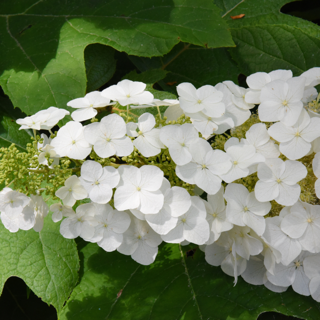 Hydrangea quercifolia – Oakleaf Hydrangeas are native and produce conical white blooms next to large leaves similar to those of an Oak tree. The foliage becomes the star of the show in fall as it morphs from green to bronze, orange and red as temperatures cool down. Flowers develop on old wood from last year’s growth and should be pruned or deadheaded soon after flowering to allow time to develop flower buds for the following year.
Hydrangea quercifolia – Oakleaf Hydrangeas are native and produce conical white blooms next to large leaves similar to those of an Oak tree. The foliage becomes the star of the show in fall as it morphs from green to bronze, orange and red as temperatures cool down. Flowers develop on old wood from last year’s growth and should be pruned or deadheaded soon after flowering to allow time to develop flower buds for the following year.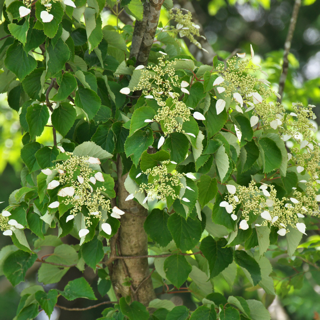 Hydrangea anomala – Climbing hydrangea is a woody vine that produces a multitude of white lacecap blooms in early to midsummer. The vine establishes itself slowly, but once the roots are established, the vines can climb quickly. Climbing hydrangea requires only minimal pruning to keep the vines under control and remove dead wood. Buds are set on old wood. Pruning or dead heading can be done after blooming occurs.
Hydrangea anomala – Climbing hydrangea is a woody vine that produces a multitude of white lacecap blooms in early to midsummer. The vine establishes itself slowly, but once the roots are established, the vines can climb quickly. Climbing hydrangea requires only minimal pruning to keep the vines under control and remove dead wood. Buds are set on old wood. Pruning or dead heading can be done after blooming occurs.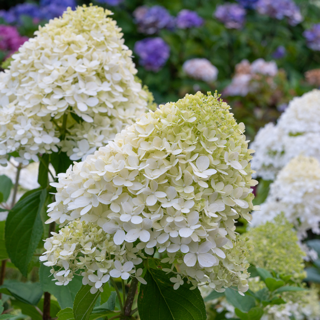 Hydrangea paniculata – While most hydrangeas prefer morning sun and afternoon shade, these can hold their own in full sun. Limelight, Little Lime, Little Lamb, Quick Fire and Pinky Winky boast striking cone-shaped blooms. Limelight is known for long-lasting blooms changing from chartreuse in summer to shades of rose in fall. Panicle hydrangeas develop flowers on new wood during the growing season. Prune while dormant in late winter or early spring before new growth appears.
Hydrangea paniculata – While most hydrangeas prefer morning sun and afternoon shade, these can hold their own in full sun. Limelight, Little Lime, Little Lamb, Quick Fire and Pinky Winky boast striking cone-shaped blooms. Limelight is known for long-lasting blooms changing from chartreuse in summer to shades of rose in fall. Panicle hydrangeas develop flowers on new wood during the growing season. Prune while dormant in late winter or early spring before new growth appears. 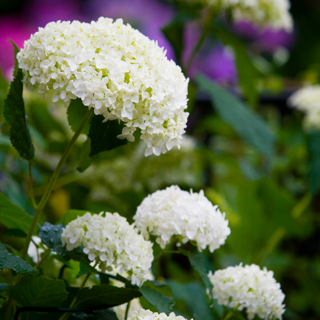 Hydrangea arborescens – Commonly known as Smooth or Wild Hydrangea, arborescens are loosely and widely branched, often with large, heavy, round blooms. Annabelle is a noteworthy cultivar, with clusters of white blooms up to 12 inches wide. Collections of arborescens offering white, cream and pink blooms include Incrediball and Invincibelle. Like paniculata, this hydrangea group sets buds on new wood and can also be pruned in late winter or early spring before new growth appears.
Hydrangea arborescens – Commonly known as Smooth or Wild Hydrangea, arborescens are loosely and widely branched, often with large, heavy, round blooms. Annabelle is a noteworthy cultivar, with clusters of white blooms up to 12 inches wide. Collections of arborescens offering white, cream and pink blooms include Incrediball and Invincibelle. Like paniculata, this hydrangea group sets buds on new wood and can also be pruned in late winter or early spring before new growth appears.  Poinsettias, Christmas Cactus, Amaryllis, Paper Whites and Cyclamen add a special touch to your home during the holidays, however, keeping them looking Merry and Bright can be challenging. Here are a few tips:
Poinsettias, Christmas Cactus, Amaryllis, Paper Whites and Cyclamen add a special touch to your home during the holidays, however, keeping them looking Merry and Bright can be challenging. Here are a few tips: Are you awed by Japanese Maple trees? Have you come into the garden center to pick one? Did the varieties overwhelm you? Let us make it easier for you by explaining Japanese maple differences. Then, when you come in, you’ll know exactly what you want.
Are you awed by Japanese Maple trees? Have you come into the garden center to pick one? Did the varieties overwhelm you? Let us make it easier for you by explaining Japanese maple differences. Then, when you come in, you’ll know exactly what you want.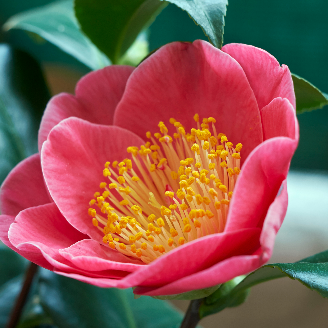
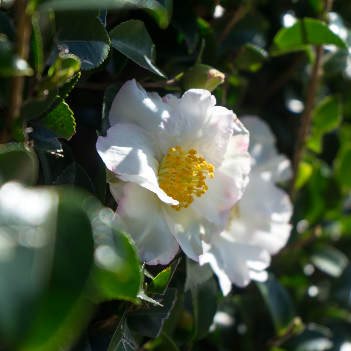
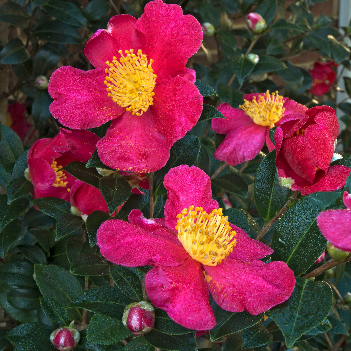
 Lime Light Hydrangea: This is simply a gorgeous hydrangea that can take the sun! Large, cone-shaped blooms beginning green, changing to white, then to rose color in the fall. Drops its leaves in late fall/winter, 6-8 ft. tall, and fast-growing.
Lime Light Hydrangea: This is simply a gorgeous hydrangea that can take the sun! Large, cone-shaped blooms beginning green, changing to white, then to rose color in the fall. Drops its leaves in late fall/winter, 6-8 ft. tall, and fast-growing.  Fragrant Tea Olive: Every home should have at least one of these evergreen shrubs. Small, fragrant, white blooms appear in spring and fall, and sometimes in-between. Plant it near an outside living space, or somewhere you are going to walk by, so that you can enjoy the fragrance. Growth can be 10-12 ft. and it can handle full or part sun. In natural form, Fragrant Tea Olive is a dense, large shrub, however, feel free to prune out the bottom branches to create a small evergreen tree.
Fragrant Tea Olive: Every home should have at least one of these evergreen shrubs. Small, fragrant, white blooms appear in spring and fall, and sometimes in-between. Plant it near an outside living space, or somewhere you are going to walk by, so that you can enjoy the fragrance. Growth can be 10-12 ft. and it can handle full or part sun. In natural form, Fragrant Tea Olive is a dense, large shrub, however, feel free to prune out the bottom branches to create a small evergreen tree.  Autumn Fern: For contrast in form in a shady area, try Autumn Fern. This evergreen fern provides interest year-round, but especially in spring when the brown fern stalks reach out and open. Very drought tolerant, growing 3-4 ft. tall and wide. Plant individually or in a group.
Autumn Fern: For contrast in form in a shady area, try Autumn Fern. This evergreen fern provides interest year-round, but especially in spring when the brown fern stalks reach out and open. Very drought tolerant, growing 3-4 ft. tall and wide. Plant individually or in a group.



 October Glory Red Maple: One of the most striking of the Red Maples, October Glory lights up the landscape in fall with bright orange/red foliage. Fairly fast growing, drops leave in winter, reaches 30-40 ft. in height. Thrives in full sun.
October Glory Red Maple: One of the most striking of the Red Maples, October Glory lights up the landscape in fall with bright orange/red foliage. Fairly fast growing, drops leave in winter, reaches 30-40 ft. in height. Thrives in full sun. Natchez Crape Myrtle: This lovely southern tree accents the landscape with a weeping growth habit, full of elongated white blooms in summer. Deciduous (drops leaves in winter), sun-loving and fast-growing, it will reach 20 ft. in height. Don’t prune, unless you need to shape it a bit; let it grow naturally to its mature size.
Natchez Crape Myrtle: This lovely southern tree accents the landscape with a weeping growth habit, full of elongated white blooms in summer. Deciduous (drops leaves in winter), sun-loving and fast-growing, it will reach 20 ft. in height. Don’t prune, unless you need to shape it a bit; let it grow naturally to its mature size.  Mediterranean Fan Palm: Any palm makes a great focal point, especially near a pool or the lake. One of the most interesting is Mediterranean or European Fan Palm, due to its multiple trunks. Palms love sun and humidity, but many are susceptible to freezing temperatures. This variety is one of the MOST cold-hardy and can hold its own around here in the winter. Slow-growing, it can eventually reach 10-15 ft.
Mediterranean Fan Palm: Any palm makes a great focal point, especially near a pool or the lake. One of the most interesting is Mediterranean or European Fan Palm, due to its multiple trunks. Palms love sun and humidity, but many are susceptible to freezing temperatures. This variety is one of the MOST cold-hardy and can hold its own around here in the winter. Slow-growing, it can eventually reach 10-15 ft.  Mahonia: For a striking show in the middle of winter, check out Mahonia. Great for a shady spot, however, a few hours of morning sun encourages the bright yellow blooms. Soft Caress is a low-growing variety (2-3 ft.) that creates a show when grouped together.
Mahonia: For a striking show in the middle of winter, check out Mahonia. Great for a shady spot, however, a few hours of morning sun encourages the bright yellow blooms. Soft Caress is a low-growing variety (2-3 ft.) that creates a show when grouped together.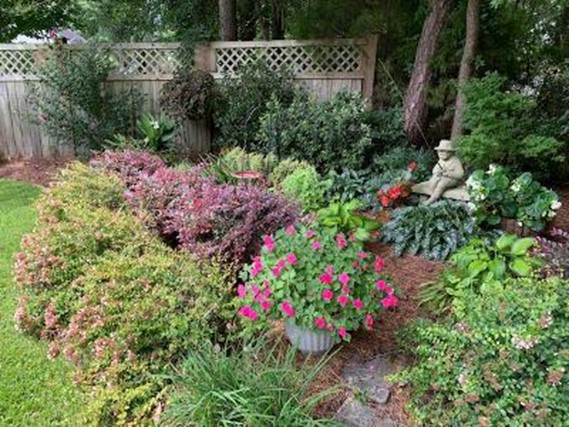 The word “design” can be a bit daunting to most of us. We immediately think of complex rules and requirements, scientific and/or architectural aspects, and then there’s the artistic element, which can be most intimidating. There is certainly much to learn in the area of landscape design, and if you are in the mood to do some research, we will provide a few resources at the end of this blog just for that purpose. But, before you jump in the deep end, let’s start with a few simple, basic principles.
The word “design” can be a bit daunting to most of us. We immediately think of complex rules and requirements, scientific and/or architectural aspects, and then there’s the artistic element, which can be most intimidating. There is certainly much to learn in the area of landscape design, and if you are in the mood to do some research, we will provide a few resources at the end of this blog just for that purpose. But, before you jump in the deep end, let’s start with a few simple, basic principles. The word succulent comes from the Latin word sucus, meaning juice or sap. By definition, succulents are plants with leaves, stems or roots that are thickened, fleshy, and engorged, usually to retain water in dry soil conditions. Water-storing… what a fantastic characteristic for plants in summer in the south! Minimal watering… Oh yeah! There are over 10,000 plants that fall into the succulent category, from many different plant species, and they provide some of the most diverse forms, colors, and blooms for inside and outside use. These unique plants provide an interesting, low-maintenance pop of plant life inside in a small space, like your desk or kitchen table, as well as outside areas like a patio or rock garden. Combine several in a decorative planter or be extra creative and plant in a terrarium or maybe even an old pair of shoes! Anything goes with these garden gems, just poke holes for drainage.
The word succulent comes from the Latin word sucus, meaning juice or sap. By definition, succulents are plants with leaves, stems or roots that are thickened, fleshy, and engorged, usually to retain water in dry soil conditions. Water-storing… what a fantastic characteristic for plants in summer in the south! Minimal watering… Oh yeah! There are over 10,000 plants that fall into the succulent category, from many different plant species, and they provide some of the most diverse forms, colors, and blooms for inside and outside use. These unique plants provide an interesting, low-maintenance pop of plant life inside in a small space, like your desk or kitchen table, as well as outside areas like a patio or rock garden. Combine several in a decorative planter or be extra creative and plant in a terrarium or maybe even an old pair of shoes! Anything goes with these garden gems, just poke holes for drainage.









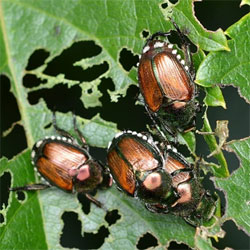 JAPANESE BEETLES – Thankfully, this little pest is creating havoc in the garden for only a few weeks, usually beginning mid-June, however, they can do quite a lot of damage in a short time, so it’s best to be on the lookout for them. They especially love roses, crape myrtles, hydrangeas, and hostas. The most effective approach to eliminate the Japanese Beetles is to use systemic pesticides and as the beetles feed, they ingest the poison in the leaves. There will be some leaf damage, but not nearly as much as with no treatment. Apply Ferti-Lome Tree & Shrub Drench in spring, or Bioadvanced 3-in-1 Insect, Disease & Mite Control in May before the beetles appear, and again in 30 days, if they are still hanging around. If you prefer the organic approach, use Spinosad Soap at the first sign of Japanese Beetles. DON’T use the traps/bags – they will attract beetles from your yard, as well as your neighbors’ yards, actually increasing the population.
JAPANESE BEETLES – Thankfully, this little pest is creating havoc in the garden for only a few weeks, usually beginning mid-June, however, they can do quite a lot of damage in a short time, so it’s best to be on the lookout for them. They especially love roses, crape myrtles, hydrangeas, and hostas. The most effective approach to eliminate the Japanese Beetles is to use systemic pesticides and as the beetles feed, they ingest the poison in the leaves. There will be some leaf damage, but not nearly as much as with no treatment. Apply Ferti-Lome Tree & Shrub Drench in spring, or Bioadvanced 3-in-1 Insect, Disease & Mite Control in May before the beetles appear, and again in 30 days, if they are still hanging around. If you prefer the organic approach, use Spinosad Soap at the first sign of Japanese Beetles. DON’T use the traps/bags – they will attract beetles from your yard, as well as your neighbors’ yards, actually increasing the population. 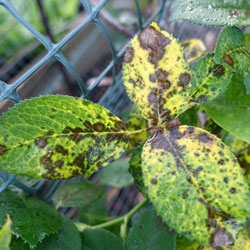
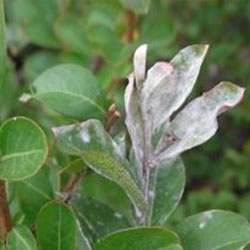 BLACK SPOT – If you have Hybrid Tea roses, you are familiar with this fungus. Because of the humidity in this neck of the woods, as well as overhead watering by sprinklers, Black Spot really gets going in the summer months. Other plants such as fruit trees, annuals, and perennials are susceptible, too, however, roses are typically hit hard.
BLACK SPOT – If you have Hybrid Tea roses, you are familiar with this fungus. Because of the humidity in this neck of the woods, as well as overhead watering by sprinklers, Black Spot really gets going in the summer months. Other plants such as fruit trees, annuals, and perennials are susceptible, too, however, roses are typically hit hard. 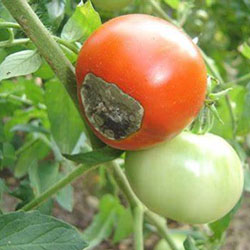 BLOSSOM END ROT – The cause of this disorder is a calcium deficiency in the developing fruit. Extreme fluctuations in moisture, rainy or cloudy weather with high humidity, cool temperatures, insufficient soil calcium, root pruning from nearby cultivation, and excessive ammoniacal nitrogen, potassium, or magnesium fertilization can also increase the chances of blossom end rot, especially early in the season. A soil test in January is advised for in-ground gardening to address the deficiencies; follow the recommendations for soil additives if needed and the soil will be ready for planting in spring. For most container gardens, adding Calcium Nitrate at time of planting and 2 weeks after will prevent Blossom End Rot. If no pre-treatment is done, and Blossom End Rot shows up on your first harvest of tomatoes, spray foliage with Ferti-lome Yield Booster, a liquid calcium treatment and the next round of tomatoes should be OK. For more information on this and other tomato diseases, click here
BLOSSOM END ROT – The cause of this disorder is a calcium deficiency in the developing fruit. Extreme fluctuations in moisture, rainy or cloudy weather with high humidity, cool temperatures, insufficient soil calcium, root pruning from nearby cultivation, and excessive ammoniacal nitrogen, potassium, or magnesium fertilization can also increase the chances of blossom end rot, especially early in the season. A soil test in January is advised for in-ground gardening to address the deficiencies; follow the recommendations for soil additives if needed and the soil will be ready for planting in spring. For most container gardens, adding Calcium Nitrate at time of planting and 2 weeks after will prevent Blossom End Rot. If no pre-treatment is done, and Blossom End Rot shows up on your first harvest of tomatoes, spray foliage with Ferti-lome Yield Booster, a liquid calcium treatment and the next round of tomatoes should be OK. For more information on this and other tomato diseases, click here 